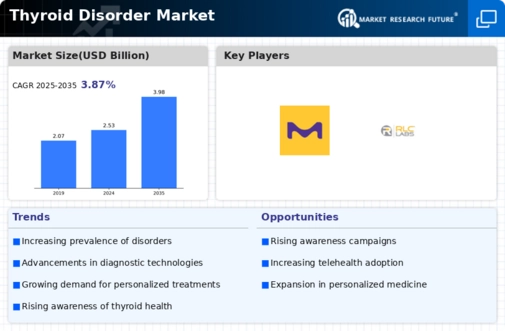Thyroid Disorder Size
Thyroid Disorder Market Growth Projections and Opportunities
The market for thyroid disorders is influenced by several key factors that shape its growth and dynamics. Firstly, the increasing prevalence of thyroid disorders worldwide drives demand for diagnostic tests, treatments, and related healthcare services. Thyroid disorders, including hypothyroidism, hyperthyroidism, and thyroid nodules, affect millions of people globally, with women being more susceptible than men. Factors such as genetic predisposition, iodine deficiency, autoimmune diseases, and environmental factors contribute to the rising incidence of thyroid disorders, leading to a growing demand for medical interventions and management strategies.
Moreover, advancements in diagnostic technologies and screening protocols play a crucial role in driving market expansion. As healthcare providers adopt more sensitive and specific tests for thyroid function assessment, such as thyroid-stimulating hormone (TSH) assays, free thyroxine (FT4) tests, and thyroid ultrasound imaging, the detection and diagnosis of thyroid disorders become more accurate and efficient. Early detection enables timely intervention and appropriate treatment, improving patient outcomes and driving demand for diagnostic tests and imaging modalities.
Furthermore, regulatory factors influence the thyroid disorder market landscape. Regulatory agencies such as the FDA (Food and Drug Administration) in the United States and the European Medicines Agency (EMA) in Europe impose regulations on the approval, manufacturing, and marketing of drugs, medical devices, and diagnostic tests for thyroid disorders. Compliance with regulatory standards is essential for manufacturers to gain market approval and ensure consumer safety and product efficacy. Changes in regulations or the introduction of new standards may impact market dynamics by affecting product development timelines and market entry strategies.
Additionally, market competition drives innovation and influences pricing strategies within the thyroid disorder market. With numerous pharmaceutical companies and diagnostic test manufacturers competing in the market, there's a constant push for the development of novel therapies, diagnostic tools, and treatment protocols. Manufacturers strive to differentiate their products through factors such as efficacy, safety profile, ease of administration, and affordability. Price competition also plays a significant role in market dynamics, with manufacturers balancing product quality and pricing to remain competitive while maximizing profitability.
Moreover, demographic trends such as aging populations and increasing healthcare awareness impact market demand for thyroid disorder treatments and services. As populations age, the prevalence of thyroid disorders, particularly thyroid nodules and thyroid cancer, increases. Older adults are more likely to develop thyroid disorders due to age-related changes in thyroid function and an increased risk of thyroid malignancies. Additionally, increasing healthcare awareness and patient education initiatives contribute to early detection and diagnosis of thyroid disorders, driving demand for medical interventions and management strategies.
Furthermore, economic factors such as healthcare expenditure and insurance coverage influence market dynamics and consumer access to thyroid disorder treatments and services. Countries with higher healthcare spending and better insurance coverage tend to have higher adoption rates of diagnostic tests, medications, and surgical interventions for thyroid disorders. Economic downturns or fluctuations in disposable income levels may impact consumer purchasing decisions, leading to shifts in demand for healthcare-related products and services, including treatments for thyroid disorders.
Additionally, technological advancements in thyroid surgery techniques and thyroid hormone replacement therapies drive market growth and adoption. Minimally invasive surgical techniques such as endoscopic thyroidectomy and robotic-assisted thyroidectomy offer patients less scarring, faster recovery times, and reduced post-operative complications compared to traditional open surgeries. Similarly, advancements in thyroid hormone replacement therapies, such as long-acting formulations and personalized dosing regimens, improve patient adherence and quality of life.
Lastly, public health initiatives and government policies promoting thyroid health awareness and preventive healthcare contribute to market expansion. Governments and healthcare organizations worldwide are increasingly investing in thyroid disease screening programs, iodine supplementation initiatives, and public education campaigns to raise awareness about the importance of thyroid health and early detection of thyroid disorders. These initiatives aim to reduce the burden of thyroid disorders on public health systems and improve outcomes for individuals affected by thyroid diseases.






Leave a Comment